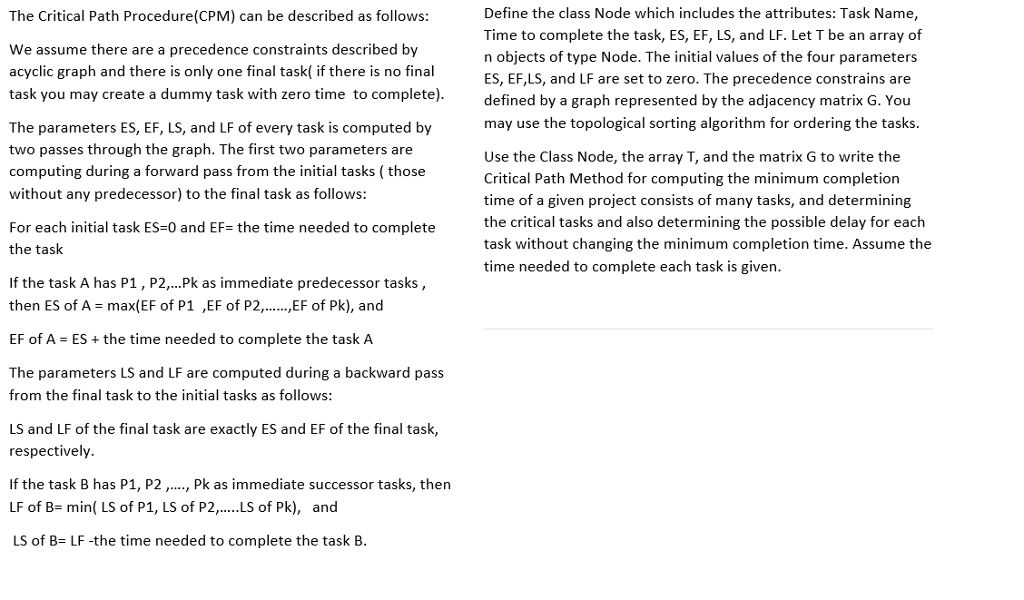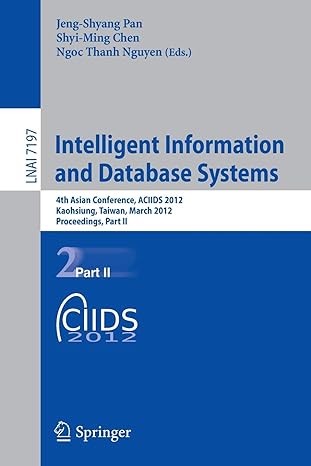
Define the class Node which includes the attributes: Task Name, Time to complete the task, ES, EF, LS, and LF. Let T be an array of n objects of type Node. The initial values of the four parameters ES, EF,LS, and LF are set to zero. The precedence constrains are defined by a graph represented by the adjacency matrix G. You may use the topological sorting algorithm for ordering the tasks The Critical Path Procedure(CPM) can be described as follows: We assume there are a precedence constraints described by acyclic graph and there is only one final task( if there is no final task you may create a dummy task with zero time to complete) The parameters ES, EF, LS, and LF of every task is computed by two passes through the graph. The first two parameters are computing during a forward pass from the initial tasks ( those without any predecessor) to the final task as follows: Use the Class Node, the array T, and the matrix G to write the Critical Path Method for computing the minimum completion time of a given project consists of many tasks, and determining the critical tasks and also determining the possible delay for each task without changing the minimum completion time. Assume the time needed to complete each task is given For each initial task ES 0 and EF- the time needed to complete the task If the task A has P1, P2..Pk as immediate predecessor tasks, then ES of A = max(EF of P1 ,EF of P2, ,EF of Pk), and EF of A ESthe time needed to complete the task A The parameters LS and LF are computed during a backward pass from the final task to the initial tasks as follows: LS and LF of the final task are exactly ES and EF of the final task, respectively If the task B has P1, P2., Pk as immediate successor tasks, then LF of B= min( LS of P1, LS of P2,..LS of Pk), and LS of B= LF-the time needed to complete the task B Define the class Node which includes the attributes: Task Name, Time to complete the task, ES, EF, LS, and LF. Let T be an array of n objects of type Node. The initial values of the four parameters ES, EF,LS, and LF are set to zero. The precedence constrains are defined by a graph represented by the adjacency matrix G. You may use the topological sorting algorithm for ordering the tasks The Critical Path Procedure(CPM) can be described as follows: We assume there are a precedence constraints described by acyclic graph and there is only one final task( if there is no final task you may create a dummy task with zero time to complete) The parameters ES, EF, LS, and LF of every task is computed by two passes through the graph. The first two parameters are computing during a forward pass from the initial tasks ( those without any predecessor) to the final task as follows: Use the Class Node, the array T, and the matrix G to write the Critical Path Method for computing the minimum completion time of a given project consists of many tasks, and determining the critical tasks and also determining the possible delay for each task without changing the minimum completion time. Assume the time needed to complete each task is given For each initial task ES 0 and EF- the time needed to complete the task If the task A has P1, P2..Pk as immediate predecessor tasks, then ES of A = max(EF of P1 ,EF of P2, ,EF of Pk), and EF of A ESthe time needed to complete the task A The parameters LS and LF are computed during a backward pass from the final task to the initial tasks as follows: LS and LF of the final task are exactly ES and EF of the final task, respectively If the task B has P1, P2., Pk as immediate successor tasks, then LF of B= min( LS of P1, LS of P2,..LS of Pk), and LS of B= LF-the time needed to complete the task B







